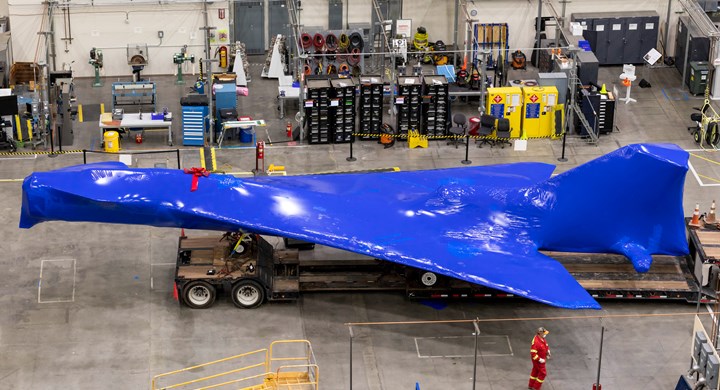Quiet supersonic demonstrator X-59 begins ground testing in Texas
Critical testing ensure the composite aircraft can withstand the loads and stresses that typically occur during supersonic flight.

NASA’s X-59 Quiet SuperSonic Technology aircraft (QueSST) is pictured here at Lockheed Martin Skunk Works in California, wrapped up in preparation for its move to Texas. Photo Credit: Lockheed Martin.
With significant milestones achieved in the assembly of NASA’s composites-intensive X-59 Quiet SuperSonic Technology aircraft (QueSST) in 2021, all eyes now look forward to a pivotal 2022. Following the X-plane’s temporary move from Lockheed Martin’s Skunk Works facility in Palmdale, Calif., U.S., to its facilities in Texas, the X-59 is set to start the new year with critical ground testing, as progress continues toward NASA’s target of the aircraft’s first flight later this year.
While in Texas, ground testing of the X-59 will ensure the aircraft can withstand the loads and stresses that typically occur during supersonic flight. The team will also calibrate and test the fuel systems before the X-59 makes the journey back to California for more tests and completion.
The X-59 is designed to reduce the loudness of the sonic boom, which occurs when an aircraft flies faster than the speed of sound, to a gentle, quiet sonic “thump.” The X-plane will demonstrate this in flights over communities around the U.S. starting in 2024, as NASA collects data that could open the future to commercial supersonic flights over land (learn more about this effort, “Lockheed Martin prepares X-59 for quiet supersonic flight testing”).
The primary composite component of the X-59 is the single-piece delta wing. Ingersoll’s (Rockford, Ill., U.S.) Mongoose system manufactures the wing skins via automated fiber placement (AFP). Holes for assembly to the fuselage and tail are made using an automated drilling system. Importantly, the aircraft is designed so that the engine and intake/exhaust systems are on top of the aircraft, instead of underneath, effectively muffling the boom that occurs upon reaching supersonic speeds.
Related Content
-
Cutting 100 pounds, certification time for the X-59 nose cone
Swift Engineering used HyperX software to remove 100 pounds from 38-foot graphite/epoxy cored nose cone for X-59 supersonic aircraft.
-
Active core molding: A new way to make composite parts
Koridion expandable material is combined with induction-heated molds to make high-quality, complex-shaped parts in minutes with 40% less material and 90% less energy, unlocking new possibilities in design and production.
-
Improving carbon fiber SMC simulation for aerospace parts
Simutence and Engenuity demonstrate a virtual process chain enabling evaluation of process-induced fiber orientations for improved structural simulation and failure load prediction of a composite wing rib.



